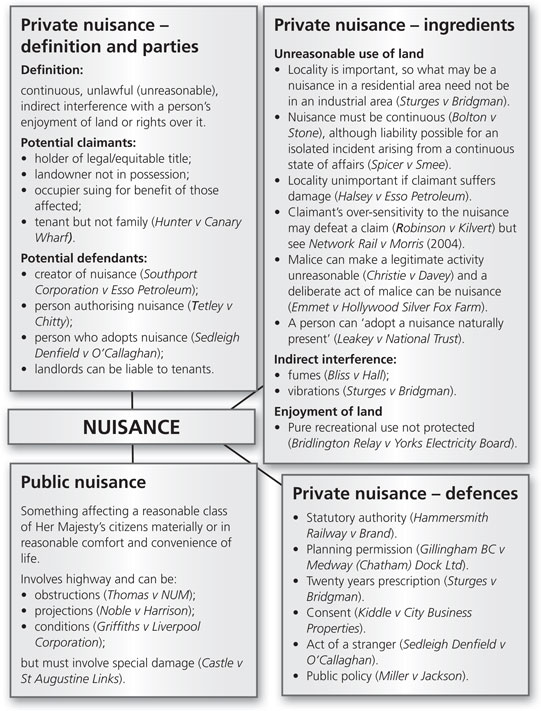Nuisance
Nuisance

4.1.1 The Definition, Character and Purpose of the Tort
1. Defined as ‘continuous, unlawful and indirect interference with a person’s enjoyment of land or some right over, or in connection with it.’
2. It only applies to an ‘indirect’ interference – direct is trespass.
3. It concerns prevention more than compensation.
4. It concerns the relationship between neighbours.
5. There are three key elements to neighbourhood:
 continuity – involving a recurring state of affairs;
continuity – involving a recurring state of affairs;
 people should be free to use their land as they wish, so long as it does not harm their neighbours;
people should be free to use their land as they wish, so long as it does not harm their neighbours;
 neighbours are subject to many trivial disputes, so there is a risk of the courts being flooded with claims.
neighbours are subject to many trivial disputes, so there is a risk of the courts being flooded with claims.
6. Only ‘unreasonable’ interference is a nuisance:
 so there is no protection against interference classed as reasonable;
so there is no protection against interference classed as reasonable;
 but if classed as unreasonable it is irrelevant whether it was reasonable for the defendant to engage in such behaviour.
but if classed as unreasonable it is irrelevant whether it was reasonable for the defendant to engage in such behaviour.
7. The test is: what conduct is sufficient to justify legal intervention?
8. The court must strike a balance between conflicting interests and this now involves balancing the rights of the individual against that of the wider community even where violation of human rights (Article 8) is involved (Hatton v UK (2003); Dennis v MoD (2003); Marcic v Thames Water Utilities Limited (2003)).
4.1.2 Who can Sue in Nuisance
1. Nuisance usually affects occupiers, so traditionally a claimant is the holder of a legal or equitable title – but might include:
a) a landowner out of possession;
b) an occupier suing for the benefit of others affected;
c) a tenant, but not his/her family:
 limiting a landlord’s responsibility for the state of property (Habinteng Housing Association v James (1994));
limiting a landlord’s responsibility for the state of property (Habinteng Housing Association v James (1994));
 so Law Commission Report No 238, 1996 recommends updating the implied covenant of fitness for human habitation in the Landlord and Tenant Act 1985;
so Law Commission Report No 238, 1996 recommends updating the implied covenant of fitness for human habitation in the Landlord and Tenant Act 1985;
4.1.3 The Ingredients of the Tort
There are three key elements:
a) unlawful use of land;
b) indirect interference with land;
c) indirect interference with the claimant’s use or enjoyment of his/her land.
The Unlawful (Unreasonable) Use of Land
1. Interference alone is insufficient – it must be unlawful.
2. Unlawful means unreasonable so, in balancing competing interests, the question is whether in all of the circumstances it is reasonable for the claimant to suffer the particular interference.
3. In assessing the defendant’s conduct the court is analysing fault (so there must be foreseeable damage), but in a more flexible way than with negligence – so a defendant might be excused liability for not having the resources to avoid the nuisance (Solloway v Hampshire County Council (1981)), but see Hurst & another v Hampshire County Council (1997) CA.
4. Many key factors are used to assess what is unreasonable.
a) The locality:
 The activity may be a nuisance in a residential area but not in an industrial one (Sturges v Bridgman (1879), where vibrations were a nuisance to a doctor’s waiting room).
The activity may be a nuisance in a residential area but not in an industrial one (Sturges v Bridgman (1879), where vibrations were a nuisance to a doctor’s waiting room).
 So it can include a common facility in the wrong area (Laws v Florinplace (1981)).
So it can include a common facility in the wrong area (Laws v Florinplace (1981)).
 The customary use of the area may be a factor (Sturges v Bridgman (1879)).
The customary use of the area may be a factor (Sturges v Bridgman (1879)).
 Locality may be irrelevant if damage is suffered (St Helens Smelting Co v Tippin (1865)).
Locality may be irrelevant if damage is suffered (St Helens Smelting Co v Tippin (1865)).
 Courts may in any case try to reach a compromise (Dunton v Dover DC (1977)).
Courts may in any case try to reach a compromise (Dunton v Dover DC (1977)).
b) The duration of the interference:
 The interference must be continuous (Bolton v Stone (1950)).
The interference must be continuous (Bolton v Stone (1950)).
 The cause could be over a long time span (Cambridge Water Co v Eastern Counties Leather PLC (1994)).
The cause could be over a long time span (Cambridge Water Co v Eastern Counties Leather PLC (1994)).
 But very short time spans have been accepted (Crown River Cruises Ltd v Kimbolton Fireworks Ltd (1996)).
But very short time spans have been accepted (Crown River Cruises Ltd v Kimbolton Fireworks Ltd (1996)).
c) The seriousness of the interference:

